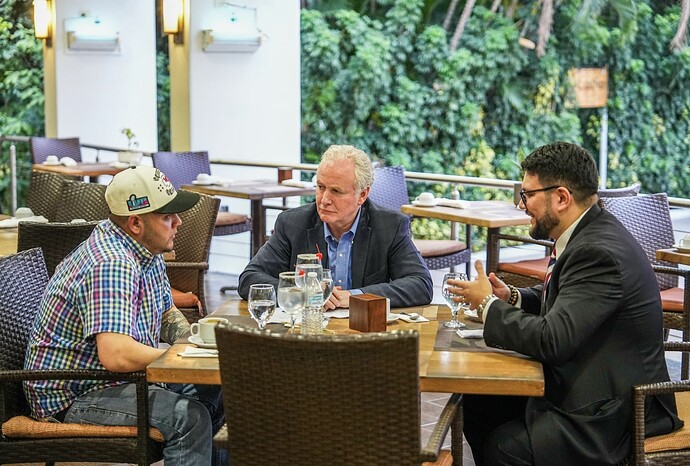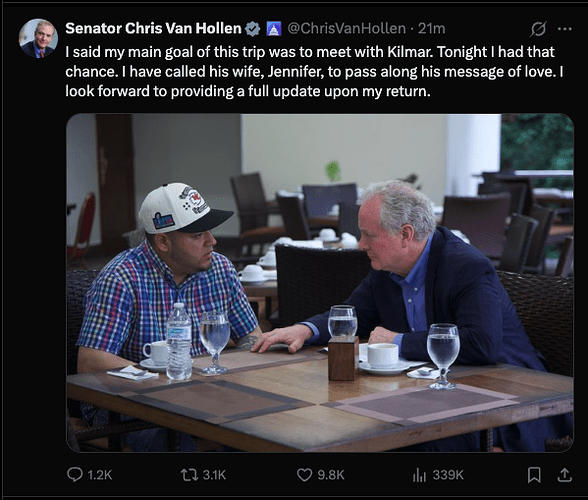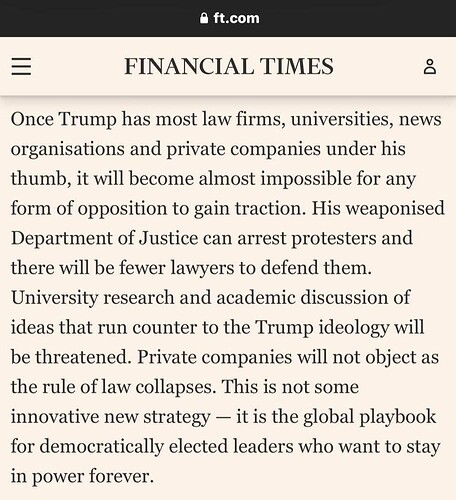Once you have paid him the Dongeld, you never get rid of the Don ![]()
![]()
When I lived in New Jersey, the company we hired to clean our house was run by an immigrant woman from Brazil, and all of the women who worked for her were from Brazil, most of them her family members. Anyway, we got to know one of them pretty well. She hated Bolsonaro. And also Trump. I hope she is doing ok, because I’m not sure she was here legally. The owner of the business was. She’d been here a long time. But I’m pretty sure some of her employees were undocumented. Hopefully they’re all ok. I should check in with her. I have her phone number.
I understand those who hate Mr. Lula da Silva, those who hate the Workers’ Party and those who fear the specter of communism. But I cannot understand those who admire Mr. Bolsonaro. A man who spent more than 20 years being elected and reelected to the Chamber of Deputies and only had two bills approved and became law. One of them extended the tax exemption for some industrial products and another defended the use of a drug without scientific proof for the treatment of cancer (this medication was later banned in the country due to risks to people’s health).
This story seems like a re-play of many similar tales of bogus cancer cures of the past. They all seem to follow a similar pattern:
- Someone dreams up a ‘cure’ for all cancers that is cheap and free of side-effects.
- This appeals to many desperate cancer patients who are fighting for their lives.
- It also attracts several entrepreneurs who are hoping to make a fast buck.
- The story is picked up by the press and consequently a sizable grass-roots movement of support emerges.
- Populist politicians jump on the vote-winning band-waggon.
- The experts caution that the bogus cancer ‘cure’ is devoid of evidence and might put patients’ lives at risk.
- The legislators get involved.
- Law suits start left, right and centre.
- Eventually, the cancer ‘cure’ is scientifically tested and confirmed to be bogus.
- Eventually, the law rules against the bogus ‘cure’.
- A conspiracy theory emerges stating that the cancer ‘cure’ was unjustly suppressed to protect the interests of Big Pharma.
- A few years later, the subject re-surfaces and the whole cycle starts from the beginning.
Ok, so good news. Abrego Garcia is still alive, and Senator Chris Van Hollen was allowed to meet with him
Bad news: this picture was tweeted out by El Salvador’s President, the guy on the right, so . . . photo op I don’t really trust, but it looks real.
During the pandemic, Mr. Bolsonaro spoke badly about vaccines, going so far as to say that if someone took the vaccine and turned into an alligator, they would not be able to cry afterwards. When a political opponent launched a Chinese vaccine and even administered it to the president’s mother, Mr. Bolsonaro had to rethink his thinking and sought out international laboratories to buy immunizing agents, but he still continued to promote ineffective drugs for the treatment of Covid.
If he had been a little smarter, he would have bought the vaccines and been reelected, but that would be asking too much of that man.
Okay, I’m glad he’s alive and that Van Hollen got to see him… but yeah, I’m wondering about the spin here, too.
The problem is, T****ers have spent the last ten years building up an immunity to cognitive dissonance.

Ok, Van Hollen tweeted out the picture as well. More info.
https://www.reuters.com/world/americas/us-senator-van-hollen-says-he-met-wrongly-deported-man-el-salvador-2025-04-18/
ETA: As I continue to look at the picture, I can’t help but notice only one of those three men looks happy.
ETA, Pt. 2: Abrego Garcia is wearing a KC Chiefs hat. All the more reason to like him (a little levity…which I need badly over this story).
Good… very good. Whether or not this will facilitate release is another question…
For some reason, the tweet isn’t showing up for me on the story… can you post a screen shot?
![]()
Thanks! It was also posted over here…
That no longer matters.
That doesn’t look like Bukele.
Yeah I think you’re right, but Bukele did tweet out that photo.
Might be a translator?
Brooks’s opinion piece in full:
In the beginning there was agony. Under the empires of old, the strong did what they willed and the weak suffered what they must.
But over the centuries, people built the sinews of civilization: Constitutions to restrain power, international alliances to promote peace, legal systems to peacefully settle disputes, scientific institutions to cure disease, news outlets to advance public understanding, charitable organizations to ease suffering, businesses to build wealth and spread prosperity, and universities to preserve, transmit and advance the glories of our way of life. These institutions make our lives sweet, loving and creative, rather than nasty, brutish and short.
Trumpism is threatening all of that. It is primarily about the acquisition of power — power for its own sake. It is a multifront assault to make the earth a playground for ruthless men, so of course any institutions that might restrain power must be weakened or destroyed. Trumpism is about ego, appetite and acquisitiveness and is driven by a primal aversion to the higher elements of the human spirit — learning, compassion, scientific wonder, the pursuit of justice.
So far, we have treated the various assaults of President Trump and the acolytes in his administration as a series of different attacks. In one lane they are going after law firms. In another they savaged U.S.A.I.D. In another they’re attacking our universities. On yet another front they’re undermining NATO and on another they’re upending global trade.
But that’s the wrong way to think about it. These are not separate battles. This is a single effort to undo the parts of the civilizational order that might restrain Trump’s acquisition of power. And it will take a concerted response to beat it back.
So far, each sector Trump has assaulted has responded independently — the law firms seek to protect themselves, the universities, separately, try to do the same. Yes, a group of firms banded together in support of the firm Perkins Coie, but in other cases it’s individual law firms trying to secure their separate peace with Trump. Yes, Harvard eventually drew a line in the sand, but Columbia cut a deal. This is a disastrous strategy that ensures that Trump will trample on one victim after another. He divides and conquers.
Slowly, many of us are realizing that we need to band together. But even these efforts are insular and fragmented. Several members of the Big Ten conference are working on forming an alliance to defend academic freedom. Good. But that would be 18 schools out of roughly 4,000 degree-granting American colleges and universities.
So far, the only real hint of something larger — a mass countermovement — has been the rallies led by Bernie Sanders and Alexandria Ocasio-Cortez. But this too is an ineffective way to respond to Trump; those partisan rallies make this fight seem like a normal contest between Democrats and Republicans.
What is happening now is not normal politics. We’re seeing an assault on the fundamental institutions of our civic life, things we should all swear loyalty to — Democrat, independent or Republican.
It’s time for a comprehensive national civic uprising. It’s time for Americans in universities, law, business, nonprofits and the scientific community, and civil servants and beyond to form one coordinated mass movement. Trump is about power. The only way he’s going to be stopped is if he’s confronted by some movement that possesses rival power.
Peoples throughout history have done exactly this when confronted by an authoritarian assault. In their book, “Why Civil Resistance Works,” Erica Chenoweth and Maria J. Stephan looked at hundreds of nonviolent uprisings. These movements used many different tools at their disposal — lawsuits, mass rallies, strikes, work slowdowns, boycotts and other forms of noncooperation and resistance.
These movements began small and built up. They developed clear messages that appealed to a variety of groups. They shifted the narrative so the authoritarians were no longer on permanent offense. Sometimes they used nonviolent means to provoke the regime into taking violent action, which shocks the nation, undercuts the regime’s authority and further strengthens the movement. (Think of the civil rights movement at Selma.) Right now, Trumpism is dividing civil society; if done right, the civic uprising can begin to divide the forces of Trumpism.
Chenoweth and Stephan emphasize that this takes coordination. There doesn’t always have to be one charismatic leader, but there does have to be one backbone organization, one coordinating body that does the work of coalition building.
In his book “Upheaval,” Jared Diamond looked at countries that endured crises and recovered. He points out that the nations that recover don’t catastrophize — they don’t say everything is screwed up and we need to burn it all down. They take a careful inventory of what is working well and what is working poorly. Leaders assume responsibility for their own share of society’s problems.
This struck me as essential advice for Americans today. We live in a country with catastrophically low levels of institutional trust. University presidents, big law firms, media organizations and corporate executives face a wall of skepticism and cynicism. If they are going to participate in a mass civic uprising against Trump, they have to show the rest of the country that they understand the establishment sins that gave rise to Trump in the first place. They have to show that they are democratically seeking to reform their institutions. This is not just defending the establishment; it’s moving somewhere new.
Let’s take the universities. I’ve been privileged to teach at American universities off and on for nearly 30 years and I get to visit a dozen or two others every year. These are the crown jewels of American life. They are hubs of scientific and entrepreneurial innovation. In a million ways, the scholars at universities help us understand ourselves and our world.
I have seen it over and over: A kid comes on campus as a freshman, inquisitive but unformed. By senior year, there is something impressive about her. She is awakened, cultured, a critical thinker. The universities have performed their magic once again.
People flock from all over the world to admire our universities.
But like all institutions, they have their flaws. Many have allowed themselves to become shrouded in a stifling progressivism that tells half the country: Your voices don’t matter. Through admissions policies that favor rich kids, the elite universities have contributed to a diploma divide. If the same affluent families come out on top generation after generation, then no one should be surprised if the losers flip over the table.
In other words, a civic uprising has to have a short-term vision and a long-term vision. Short term: Stop Trump. Foil his efforts. Pile on the lawsuits. Turn some of his followers against him. The second is a long-term vision of a fairer society that is not just hard on Trump, but hard on the causes of Trumpism — one that offers a positive vision. Whether it’s the universities, the immigration system or the global economy, we can’t go back to the status quo that prevailed when Trump first rode down the escalator.
I’m really not a movement guy. I don’t naturally march in demonstrations or attend rallies that I’m not covering as a journalist. But this is what America needs right now. Trump is shackling the greatest institutions in American life. We have nothing to lose but our chains.
Not all of us have treated it as a series of different attacks. All of this was laid out in Project 2025. ALL. OF. IT. We warned you. We warned everyone.




